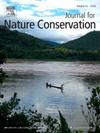Evaluating the effectiveness of protected areas in preserving ecosystem processes via remote Sensing: A review
IF 2.5
3区 环境科学与生态学
Q2 BIODIVERSITY CONSERVATION
引用次数: 0
Abstract
Evaluating the effectiveness of protected areas (PAs) in preserving ecosystem processes remains a major scientific challenge. This study reviews the application of remote sensing techniques in assessing PA effectiveness, analyzing publication trends, key contributors, and methodological approaches from 1988 to 2022. A bibliometric and systematic review approach was conducted using the Scopus database, employing co-occurrence network analysis, citation analysis, and statistical assessments. The results indicate a substantial increase in research activity, with 874 publications identified, reflecting an annual growth rate of 14.92%. China (27.1% of publications), the U.S. (26.5%), and the U.K. (9.15%) lead global contributions. Remote sensing, mainly using Landsat (60% of studies), MODIS, and Sentinel imagery, has been instrumental in evaluating deforestation, land-use change, and ecosystem integrity within PAs. The most analyzed PA types were national parks, reserves, and forests, with significant threats including deforestation, fires, and land-use conversion. Despite research expansion, uncertainties persist regarding PA effectiveness, with many areas failing to prevent biodiversity loss due to external pressures. The study highlights that while remote sensing has significantly advanced PA monitoring, it is often limited by a lack of integration with socio-economic and ecological dimensions. Future research should focus on interdisciplinary approaches, incorporating high-resolution remote sensing data and adaptive management strategies to enhance conservation outcomes. Strengthening international collaboration and refining methodologies will improve protected areas’ long-term resilience and effectiveness.
利用遥感评价保护区保护生态系统过程的有效性:综述
评估保护区在保护生态系统过程中的有效性仍然是一个重大的科学挑战。本研究回顾了1988年至2022年遥感技术在评估PA有效性、分析出版趋势、主要贡献者和方法方法方面的应用。采用文献计量学和系统评价方法,使用Scopus数据库,采用共现网络分析、引文分析和统计评估。结果表明,研究活动大幅增加,共发现874篇出版物,年增长率为14.92%。中国(27.1%)、美国(26.5%)和英国(9.15%)是全球贡献最多的国家。遥感,主要使用陆地卫星(60%的研究)、MODIS和哨兵图像,在评估森林砍伐、土地利用变化和生态系统完整性方面发挥了重要作用。分析最多的PA类型是国家公园、保护区和森林,主要威胁包括毁林、火灾和土地利用转换。尽管研究扩大了,但关于PA有效性的不确定性仍然存在,许多地区由于外部压力而未能防止生物多样性的丧失。该研究强调,虽然遥感在很大程度上促进了对PA的监测,但由于缺乏与社会经济和生态方面的结合,它往往受到限制。未来的研究应集中在跨学科的方法上,结合高分辨率遥感数据和适应性管理策略来提高保护成果。加强国际合作和改进方法将提高保护区的长期恢复力和有效性。
本文章由计算机程序翻译,如有差异,请以英文原文为准。
求助全文
约1分钟内获得全文
求助全文
来源期刊

Journal for Nature Conservation
环境科学-生态学
CiteScore
3.70
自引率
5.00%
发文量
151
审稿时长
7.9 weeks
期刊介绍:
The Journal for Nature Conservation addresses concepts, methods and techniques for nature conservation. This international and interdisciplinary journal encourages collaboration between scientists and practitioners, including the integration of biodiversity issues with social and economic concepts. Therefore, conceptual, technical and methodological papers, as well as reviews, research papers, and short communications are welcomed from a wide range of disciplines, including theoretical ecology, landscape ecology, restoration ecology, ecological modelling, and others, provided that there is a clear connection and immediate relevance to nature conservation.
Manuscripts without any immediate conservation context, such as inventories, distribution modelling, genetic studies, animal behaviour, plant physiology, will not be considered for this journal; though such data may be useful for conservationists and managers in the future, this is outside of the current scope of the journal.
 求助内容:
求助内容: 应助结果提醒方式:
应助结果提醒方式:


